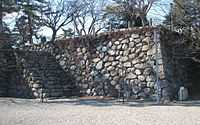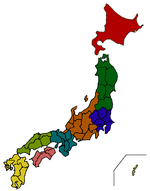Matsusaka Castle
| Matsusaka Castle 松阪城 | |
|---|---|
| Matsusaka, Mie Prefecture, Japan | |
 | |
| portion of the foundations of the Main Keep of Matsusaka Castle | |
| Coordinates | Coordinates: 34°42′33″N 136°31′33″E / 34.70917°N 136.52583°E |
| Type | flatland-style Japanese castle |
| Site information | |
| Open to the public |
yes |
| Condition | ruins |
| Site history | |
| Built | 1588 |
| In use | Edo period |
| Built by | Gamō Ujisato |
Matsusaka Castle (松坂城 Matsusaka-jō) was a Japanese castle (now in ruins) located in Matsusaka, Mie Prefecture, Japan. Throughout most of the Edo period, Matsusaka Castle was a secondary administrative center for the Kishu-Tokugawa clan, daimyō of Kishū Domain. The site has been proclaimed a National Historic Site by the Japanese government.
History
In 1584, by order of Oda Nobunaga, Gamō Ujisato was transferred from his 60,000 koku holdings in Omi Province to a new 123,000 koku domain in Ise Province. In 1588, feeling that Matsugashima Castle on Ise Bay was indefensible, he relocated his seat further inland, to the current site of Matsusaka Castle. Construction was completed in a very short time, partly through the destruction of local Buddhist temples and an ancient kofun burial mound, to use the stones in the construction of the defensive walls. The inhabitants of Matsugashima were forcibly resettled at the new castle town, and merchants were invited from the Gamō’s former domain in Omi. The completed castle had two concentric moats, and a three-roof/five-story tenshu (donjon).
However, in 1590, after the Battle of Odawara, the Gamō clan was rewarded by Toyotomi Hideyoshi with a transfer to Aizu-Wakamatsu (600,000 koku). Matsusaka Castle was given to a Toyotomi retainer, Hattori Kazutada. In 1595, the Hattori were purged by Hideyoshi, together with Toyotomi Hidetsugu and the domain was given to Furuta Shigekatsu, with a much-reduced revenue base of 34,000 koku. The Furuta were confirmed in their holdings by Tokugawa Ieyasu and their revenues increased to 54,000 koku after the Battle of Sekigahara.
In 1619, the Furuta clan was transferred to Hamada in Iwami Province, and Matsusaka Domain was abolished, with its territories incorporated into the holdings of the Kishu-Tokugawa clan of Kishū Domain, based in Wakayama. Despite the official policy of “one country-one castle”, the existing fortifications at Matsusaka were not destroyed, but were retained as an administrative center for the domain’s 179,000 koku holdings in southern Ise Province. However, in 1644, the donjon was destroyed by a typhoon, and was not rebuilt. In 1794, a jinya fortified residence was built. The Kishu-Tokugawa clan retained the territory until the Meiji Restoration.
In 1877, a fire destroyed the palace within the second bailey, and in 1881 all of the remaining castle buildings were pulled down, with the exception of a single rice warehouse.
In 1982, a proposal to reconstruct the donjon was vetoed due to local opposition. From 1988-2003, the moats and stonework underwent a massive repair and reconstruction process. During this time, it was discovered that much of the stonework was in the same style as Azuchi Castle.
The ruins were listed as one of the 100 Fine Castles of Japan by the Japan Castle Foundation in 2006. On February 7, 2011, the site of Matsusaka Castle was proclaimed as a National Historic Site by the Japanese government.
Located on the castle site are the modern Matsusaka city hall, city hospital, a local history museum and the Motoori Norinaga Memorial Hall.[1]
Literature
- Schmorleitz, Morton S. (1974). Castles in Japan. Tokyo: Charles E. Tuttle Co. pp. 144–145. ISBN 0-8048-1102-4.
- Motoo, Hinago (1986). Japanese Castles. Tokyo: Kodansha. p. 200 pages. ISBN 0-87011-766-1.
- Mitchelhill, Jennifer (2004). Castles of the Samurai: Power and Beauty. Tokyo: Kodansha. p. 112 pages. ISBN 4-7700-2954-3.
- Turnbull, Stephen (2003). Japanese Castles 1540-1640. Osprey Publishing. p. 64 pages. ISBN 1-84176-429-9.
External links
Notes
| Wikimedia Commons has media related to Matsusaka Castle. |
| ||||||||||||||||||||||||||||
